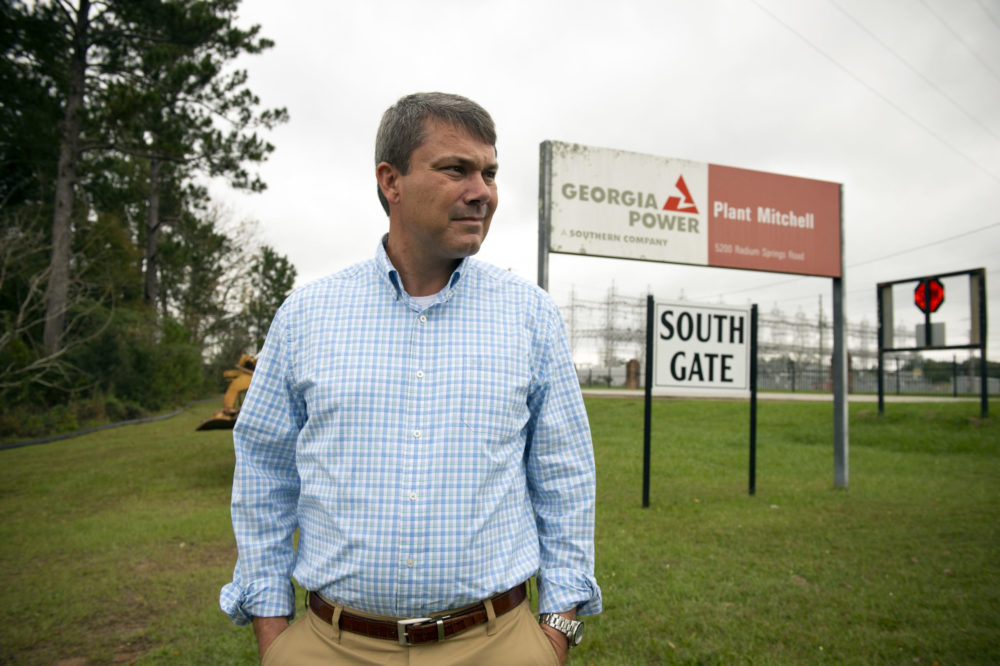Sunken Costs: The utility giant’s quiet purchasing spree could shield it from coal ash cleanup expenses
This article was produced in partnership with ProPublica, a nonprofit newsroom that investigates abuses of power. Georgia Health News is a member of the ProPublica Local Reporting Network.
By Max Blau
Over the past several years, utility giant Georgia Power has embarked on an unusual buying spree, paying top dollar for people’s property in places where cheap land was easy to find.
In 2016, it bought a veterinarian’s 5-acre lot in the rolling hills of northwest Georgia for roughly double the appraised value. The following year, it acquired 28 acres of flood-prone land in southwest Georgia’s Pecan Belt for nearly four times what the local tax assessor said it was worth. By the year after that, it had paid millions of dollars above the appraised value for hundreds of acres near a winding gravel road in a central Georgia town with no water lines and spotty cellphone service.
Two things united the properties: They were all near coal-fired power plants that generated toxic waste stored in unlined ponds at those sites. And they were all purchased after the Environmental Protection Agency finalized new regulations in 2014 governing the disposal of such waste, known as coal ash. All told, the utility paid over $15 million for nearly 1,900 acres close to five of its 12 power plant sites, according to an investigation by Georgia Health News and ProPublica.
The costly land purchases offer an enormous potential payoff to Georgia Power, one of the largest producers of coal ash waste in the country, the investigation found. They may allow the utility to forestall millions of dollars in cleanup costs outlined by the December 2014 regulations.

The Atlanta-based company is trying to convince regulators to allow it to leave more than half of its coal ash — around 48 million tons — in unlined ponds at plant sites spread across the state. Environmentalists believe the safest way to dispose of coal ash is to move it from unlined ponds into landfills that have a protective, and more costly, liner to prevent contaminants from seeping into groundwater — the source of drinking water for people who depend upon wells.
Unlined coal ash ponds frequently leak contaminants into groundwater, according to a pair of analyses of industry-reported data conducted by advocacy groups Environmental Integrity Project and Earthjustice. Recent Georgia Power tests of groundwater show that coal ash contaminants appear to be migrating out of the ponds at some plant sites, according to experts who reviewed company filings.
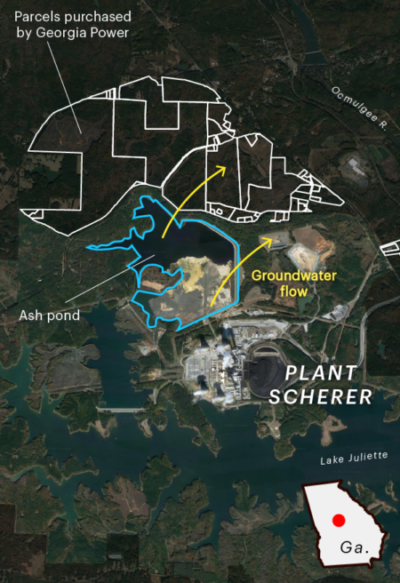
The new regulations require utilities to clean up contaminants if they are found at high enough levels beyond the boundaries of their plant sites. By extending those boundaries through land purchases, Georgia Power could push back the day it has to deal with its legacy of pollution, according to a dozen environmental experts, regulators and activists.
Betsy Southerland, former director of the Office of Science and Technology in the EPA’s Office of Water, said Georgia Power’s purchases can “move their fence line far enough out” so the higher levels of coal ash contaminants will dilute enough to fall under enforceable maximum contamination levels by the time they reach the new property border.
“It does not surprise me at all that Georgia Power is looking to acquire additional buffer lands,” said Stan Meiburg, a former EPA acting deputy administrator who reviewed Georgia Power filings obtained by GHN and ProPublica. “It gives them more ability to keep an eye on any contamination before this reaches property boundaries.”
Utility officials contend that their preferred methods of closure, which depend on the specifics of each site, are safe.
Georgia Power spokesperson John Kraft said in a recent statement that the purchased properties were intended for use as a construction buffer while the company closes its unlined ponds, a lengthy process that includes pumping water out of the disposal site and burying the remaining coal ash in place. He did not respond to direct questions about whether the purchased land would help the company delay cleanup costs.
He noted that the company, a subsidiary of the Southern Company, the nation’s second-largest energy provider, has hired experts to monitor test wells positioned around the ash ponds for signs of groundwater contamination. Based on the results of those tests, he added, the company “has identified no impact to drinking water.”
But neighbors who continue to live near coal-fired plants are suspicious of the way Georgia Power has quietly purchased the properties. The utility has required those who sell it land to sign contracts that release the company from future legal claims and forbid the sellers to voice concerns about polluted drinking water wells. They worry that Georgia Power will eventually walk away from its waste, leaving local communities exposed to the long-term risk of poisons seeping into well water — and the potential negative health care outcomes that may follow.
Federal and state regulations require Georgia Power to monitor the coal ash disposal sites for 30 years. That’s not long enough to protect those who want to set down roots for life.
When Chad Holland moved to Albany, Georgia, in 2007, just down the road from Plant Mitchell, he didn’t think twice about his water source. A private well provided the water his family used for drinking, cooking and bathing. But this past spring, while scrolling down his Facebook feed, he saw a post about coal ash.
The 49-year-old alcohol sales supervisor soon began to wonder if his water had been contaminated by waste dumped less than a mile from his family home. So he set out in search of answers.
“I had never thought anything of it,” Holland told GHN and ProPublica. “I wanted to know what was in the pond.”
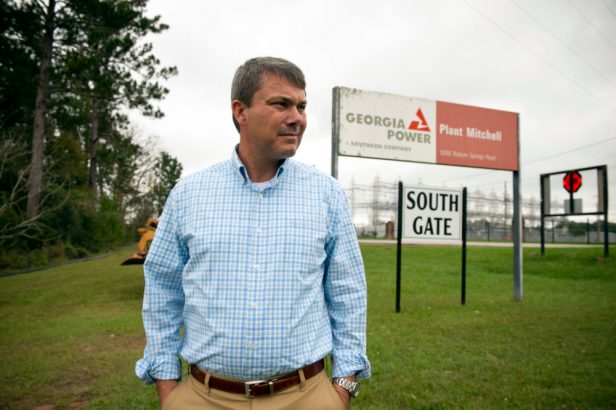
A moment of reckoning
On Dec. 22, 2008, more than a billion gallons of a toxic slurry of coal ash and water breached a dike at the Tennessee Valley Authority’s Kingston Fossil Plant about 40 miles west of Knoxville. The wave — roughly five times the volume of liquid spilled by the Deepwater Horizon disaster in the Gulf of Mexico two years later — tore up railways, toppled power lines, knocked a home off its foundation and caked the Emory River in a thick, gray sludge.
The catastrophe awakened the public to a long-hidden danger: vast amounts of coal ash stored in disposal sites at power plants across the rest of the United States. Utilities produce over 100 million tons of coal ash annually, according to the EPA, making it the nation’s second-largest source of industrial waste after household garbage.
Coal ash is the fine residue left when coal is burned to produce power. The ash contains contaminants associated with long-term health risks, including damage to the kidney (from mercury), stomach (from boron) and nervous system (from arsenic). To dispose of it, utilities can either transport the waste to a landfill with a protective liner on the bottom or mix it with water in an ash pond without a layer underneath.
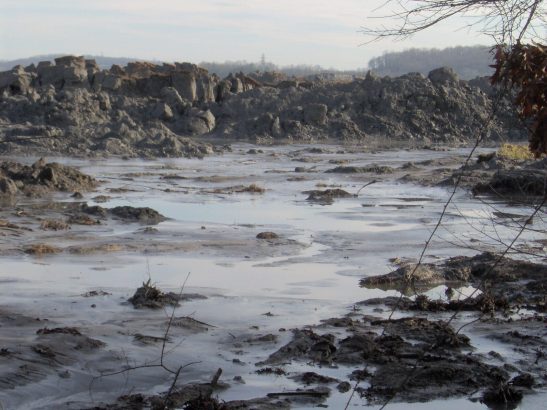
Until recently, the waste largely had been regulated by the states instead of the federal government, in part thanks to pressure from industry groups fighting stricter environmental protections. Some states, like Maryland, enacted tough standards to dispose of the waste. Georgia, however, did not follow suit, despite a growing body of science warning about the potential for unlined ponds full of contaminants to pollute aquifers that supply water to homes with drinking wells.
The Kingston spill broke a long-standing logjam in Washington. The Obama administration spent years holding hearings, studying the past research and reviewing new comments about potential coal ash regulations. On Dec. 19, 2014, EPA officials finalized the first-ever federal coal ash rule designed to reduce the risk of emergency failures, protect groundwater and outline best practices for closing ash ponds.
For decades, Georgia Power had dumped ash into ponds without a protective liner. Now, to comply with the new coal ash rule, the company would have to remove the water from its ponds. From there, it could either leave the ash in place with a cover on top, install a protective liner under the ash or remove the ash into a lined landfill.
Faced with billions of dollars in potential environmental compliance costs, the utility resorted to an old page from its corporate playbook. For much of the 20th century, Georgia Power had bought thousands of acres of land — seizing some properties through the use of eminent domain — to build new coal-fired plants. By the 1980s, the utility had expanded energy production capabilities beyond what Georgians actually needed. So it sold excess electricity outside the state, while disposing of the associated waste inside the state.
Georgia became a coal ash capital, home to over 90 million tons of waste in the communities where its plants stood.
Paying more per acre
Power plants are notorious for driving down the value of nearby homes. But since the coal ash rule was finalized, GHN and ProPublica found that Georgia Power doubled the amount it had been previously paying to acquire land.
In the six years before Dec. 19, 2014, records show that Georgia Power purchased 12 properties for an average price of over $4,000 per acre. In the nearly six years since the coal ash rule was finalized, Georgia Power bought about 75 properties for an average price of $8,800 per acre — outpacing the growth of average real estate values in rural areas of the state. The company purchased a third of those properties for over $30,000 an acre — and a handful for over $100,000 an acre.
Ten days after the EPA finalized the coal ash rule, Georgia Power spent $1.3 million to acquire 141 acres of land near Plant Bowen in the northwest part of the state. A four-acre sinkhole there had opened at the plant’s coal ash pond years earlier, releasing over 2 million gallons of arsenic-laced ash and water into a tributary of the Etowah River. In the following years, the utility also purchased 32 acres near the Plant Arkwright site in Macon; 55 acres near Plant Wansley in west Georgia; and over 1,000 acres near Plant Scherer, the nation’s largest coal-fired plant, in central Georgia.
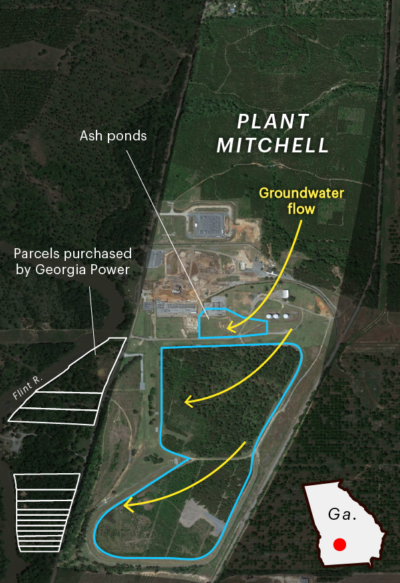
The EPA does not require utilities to disclose purchases of land near coal ash storage sites. But environmental experts say Georgia Power’s buying spree is larger than most previous residential land acquisitions by other utilities near their coal ash ponds in Florida, Indiana and North Carolina. Since December 2014, Georgia Power has acquired more land than the TVA did after its Kingston spill, according to property records. Unlike the TVA, Georgia Power has purchased land without the occurrence of a sudden catastrophe.
“It makes you wonder if they’re trying to buy you out to get you gone,” said Gloria Hammond, one of the last remaining property owners on Luther Smith Road, which runs along the northern edge of Plant Scherer.
Kraft, the Georgia Power spokesman, said the company “routinely purchases property around our generation plants.” He declined to answer questions regarding the increase in purchase prices near the company’s disposal sites since the coal ash rule was finalized.
At least one former neighbor of Georgia Power was required to sign a nondisparagement agreement. If the seller spoke negatively about the company — including any mention of prior concerns about groundwater contamination — the company could take that person to court.
After the sale, the seller, who spoke on the condition of anonymity, noticed Georgia Power post “no trespassing” signs outside the house. One of the company’s crews razed the person’s family home and sealed the drinking well on the property.
State law requires Georgia Power to seal unused drinking wells within three years to prevent accidents or illegal dumping. But environmentalists say the company should keep the wells open to monitor for potential contamination.
To this day, the seller worries about the long-term repercussions from living near the coal ash pond.
“It’s been a nightmare,” the seller said. “It’s like a death that you can’t get over.”
Contaminants spark statewide concern
On days that Holland, the alcohol sales supervisor, drove his two daughters to school, he passed by the front gates of Plant Mitchell, which had operated for decades less than a mile from his home. A tree buffer along Old Georgia Highway 3, however, obscured his view of the coal ash ponds on site.
Although Holland didn’t know it, some Georgia officials had long worried about the disposal of coal ash at Plant Mitchell. In the late 1980s, an investigator with the Georgia Environmental Protection Division, or EPD, visited coal plants across the state. At Plant Mitchell, the investigator documented evidence that “groundwater contamination is occurring via leachate from wastes generated on-site” — and could impact nearly 2,000 people who “extensively” used drinking wells, according to records stored in state archives. Kevin Chambers, a spokesman for EPD, said current agency officials could not determine whether any efforts were made at the time to address those groundwater contamination concerns.
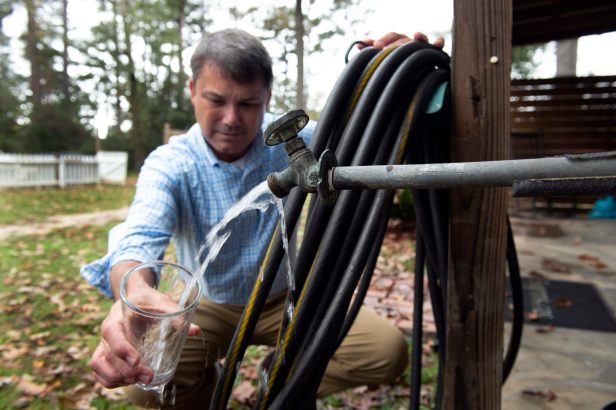
In 2015, Georgia Power shut down the power plant, which went online just after World War II. The utility left behind 2 million tons of coal ash waste stored on-site.
Around that time, Holland noticed “no trespassing” signs posted near a boat landing across the street from Plant Mitchell. A few years earlier, Holland and his father had been interested in buying a lot near the landing, which allowed access to the Flint River. He didn’t think the land was worth much because the property flooded during heavy storms. When the owner said he wanted at least $50,000, Holland didn’t even bother to make an offer. It was too much, he thought.
This past March, Holland clicked on a news article shared by one of his Facebook friends. As he scanned the article, he read about residents in Juliette, the small central Georgia town where Plant Scherer is located. They suspected the waste left behind from burning coal had contaminated local groundwater, which supplied water to their homes through wells. They’d seen friends grow sick and family members die at a young age.
Curious, he began researching property sales. When he looked up Georgia Power’s purchase of the property near the boat landing, he was floored to learn that it paid over $340,000 for the land. He also noticed that the power company had purchased nearby properties for a total of over $1.2 million, nearly four times the value appraised by the local tax assessor.
Worrisome thoughts soon raced through Holland’s head. He was never approached by Georgia Power about his property. So he called his neighbors who sold land to Georgia Power. Then, he called a law firm. None offered the answers he needed. He thought about all the times his wife and daughters had consumed the water. Was his family in danger? he wondered. He needed to know.
He was desperate for answers.
“I’m not stupid,” Holland told GHN and ProPublica. “If they’re doing that, there’s a reason for it.”
Toxins found in groundwater
In a public hearing last year, Georgia Power CEO Paul Bowers said the company’s focus “has always been on public health and safety, and ensuring we’re compliant with the EPA rules and Georgia state rules.” The company has mailed informational packets to residents near Plant Scherer, claiming that “no evidence” exists that the ash pond is responsible for groundwater contamination.
But environmental experts said data recently released by Georgia Power is cause for concern. It shows that monitoring wells at Plant Mitchell and several other plants have registered the presence of contaminants in groundwater often found in coal ash ponds. The wells lie between the ponds and land recently acquired by Georgia Power.
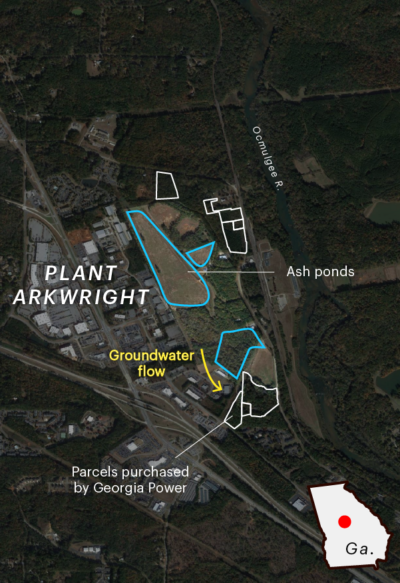
Groundwater testing at Plants Bowen and Arkwright have revealed levels of cobalt and molybdenum, toxins linked to higher risk of liver damage and other health ailments, that exceed state groundwater protection standards. Another Plant Arkwright site test found levels of lithium, a chemical that can lead to neurological damage if consumed in large enough amounts. The levels are high enough to have triggered extra monitoring and the development of cleanup plans required by coal ash regulations.
Experts who reviewed the data at the request of GHN and ProPublica said it does not offer a definitive link between contaminants found in coal ash ponds and those detected in either monitoring wells or nearby private drinking wells.
Environmental advocacy groups such as the Altamaha Riverkeeper are testing private drinking wells near coal ash ponds in an effort to establish a stronger link. Over the past two years, the group has tested about a hundred private drinking wells near Plant Scherer. Those wells contained mercury, boron, calcium, sulfate and barium — all of which are potential indicators of coal ash contaminants.
However, environmentalists noted, the swift sealing of drinking wells on the land purchased by Georgia Power will make it more difficult to establish such a link. The well closures may offer the utility protection from lawsuits by people claiming they have been sickened by contamination seeping from the coal ash ponds.
“This is a business decision,” said Jesse Demonbreun-Chapman, executive director of the Coosa River Basin Initiative, an environmental advocacy group whose purview includes the waters adjacent to Plant Bowen. “You’re cutting off liability for a waste stream they haven’t controlled.”
Georgia’s Environmental Protection Division is expected to make a final decision on how best to close the unlined ash ponds when it issues closure permits sometime next year.
Chuck Mueller, the agency’s land branch chief, said in a statement that any permit issued will require “a sufficient number” of monitoring wells to be installed so that coal ash contaminants “do not migrate beyond the permitted boundaries” of each plant site.
Unanswered questions
This past summer, Holland couldn’t stop thinking about the nearby ash ponds. Working from home at his dining room table, he wondered why a constant parade of 18-wheel trucks passed by his house coming and going from Plant Mitchell site. He grew more curious about the monitoring wells near the coal ash ponds along the side of Old Georgia Highway 3.
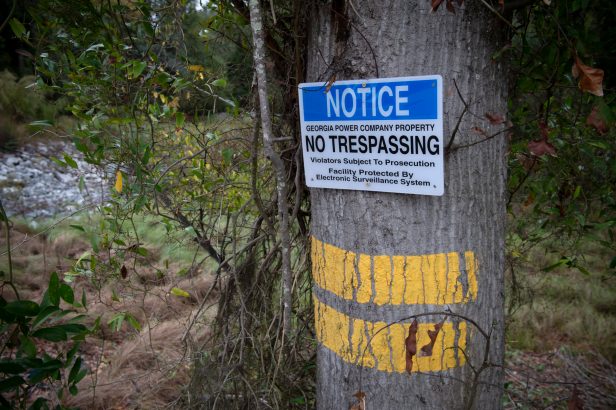
The more articles Holland read, the more he jotted down notes on his trusted yellow legal pad. He recorded a grim roll of contaminants: Hexavalent chromium. Arsenic. Lead. Mercury. He wrote down the name of a Juliette resident who sold his property to Georgia Power. Describing what Georgia Power did after some sales he read about, he wrote: “HOUSE BOUGHT. POURED CONCRETE IN WELLS.” In July, 45 central Georgia residents sued the utility, alleging that Plant Scherer’s coal ash contaminants contributed to health problems such as cancer, cardiovascular disorder and thyroid damage.
One day in early October, Holland received a phone call from Gordon Rogers, executive director of Flint Riverkeeper. Holland shared his concerns that the company’s purchases may be hiding the true extent of contamination.
Rogers was reminded of similar conversations with other residents who lived near Plant Mitchell. Rogers hoped they’d find answers, starting with an upcoming well-testing campaign to determine the extent of groundwater contamination.
The prospect of future answers hasn’t quelled Holland’s present anxiety. Tests could help ease his worry. But only some. He still felt uneasy thinking of all the years his girls drank the water without worry.
“What if my daughters get sick 10 years from now?” he said with a sigh, sitting at his dining room table. “I’m scared of what can happen down the line.”
Correction: An early version of this article misspelled the surname of a former EPA acting deputy administrator. He is Stan Meiburg, not Meiberg.
Max Blau is a freelancer working for Georgia Health News. He can be reached at maxcblau@gmail.com
Help us investigate. Do you live next to a coal plant? Do you work around coal plants or ash ponds?
ProPublica and Georgia Health News are continuing to examine the consequences of coal ash, which is the toxic waste that coal plants leave behind. Share your experiences with us by filling out this form. One of our reporters will get in touch with you soon.

